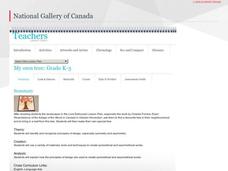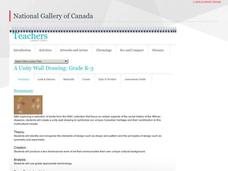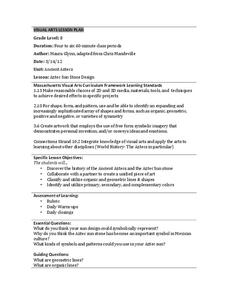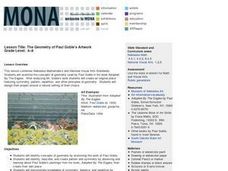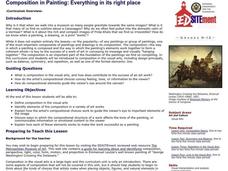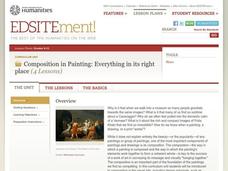Spring Branch Independent School District
Elementary Art Curriculum Guide
Get crafting with hundreds of pages of art lessons! The plans are organized into topics, which include clay, drawing, composition and design, mixed media, painting, printmaking, and paper.
Curated OER
Shaping the View: Symmetry and Balance
Students explore the symmetry and balance in the composition of a variety of art works and note how the viewer's eye is guided to the important components of the image. How these elements affect the tone of the painting and communicate...
Curated OER
Shaping the View: Symmetry and Balance
Students examine how artists structure their compositions to convey a sense of symmetry and balance. They analyze various paintings, identify objects and figures in the paintings, conduct Internet research, and evaluate paintings.
Curated OER
Shaping the View: Symmetry and Balance
Students view an image from the Metropolitan Museum of Art and identify the focal point of the painting. They discuss symmetry and balance as it pertains to the images. Students use the Student LaunchPad (linked to this lesson) to help...
Curated OER
Symmetry
Third graders find symmetry in nature. In this symmetry lesson, 3rd graders discover that symmetry is in nature and our everyday world. Students examine the alphabet for symmetrical letters then create their own artwork showing symmetry.
National Gallery of Canada
My Own Tree
Nature contains both symmetry and asymmetry. Have your young artists examine symmetry and asymmetry in their own surroundings. After viewing works of art, pupils find trees in their neighborhoods and determine if they...
National Gallery of Canada
Build a Neighbourhood
What's special about your neighborhood? Build one with your class to find out. Individuals create their dream homes that, when completed, will be placed together around a green space in order to create a neighborhood. Learners also...
University of Minnesota
Beautiful Brain: Do You See What I See?
Can art play tricks on your eyes, and can a still painting really appear to vibrate? The second lesson plan in a four-part series discusses the way our beautiful brains translate visual images. It highlights the style of optical art and...
Curated OER
A World of Symmetry
Students identify lines of symmetry. For this symmetry lesson, students create objects and identify their lines of symmetry. They answer questions about lines of symmetry. Students cut shapes out of cookie dough and...
Curated OER
Origami Ducks: Geometry, Listening, and Following Directions
Make origami ducks with your class to reinforce geometry concepts and vocabulary; develop fine motor and visual translation skills; and enrich study of Japanese culture, the pond habitat, or migration. Create a whole group "worksheet"...
Curated OER
The Geometry of Indigenous Art
Students examine the concepts of symmetry, rotations, reflections, translation, dialations, and tessellations and apply them to indigenous art. They also do Internet research and create artwork (painting, pottery, computer graphic design).
Baylor College
Water: The Math Link
Make a splash with a math skills resource! Starring characters from the children's story Mystery of the Muddled Marsh, several worksheets create interdisciplinary connections between science, language arts, and math. They...
National Gallery of Canada
The Roots of My Family
Represent family history visually by requiring your young artists to create family trees that express balance and symmetry. Pupils examine works of art, research their family histories, and put together large family tree posters.
National Gallery of Canada
A Unity Wall Drawing
Build class community with an art project. Learners first examine and discuss works of art. They then contribute to a class mural by tracing their hands and decorating them in relation to their own cultures. The final mural...
National Gallery of Canada
Tantalizing Tessellations!
Examine repeating and intricate patterns with a study of M.C. Escher and a related art activity. Pupils view and discuss the artwork before creating their own tessellating patterns. Step-by-step instructions for creating a template are...
Curated OER
Ancient Aztecs
Is it a calendar? A religious symbol? A political statement? One thing for certain is that Aztec sun stone designs remain an important symbol in Mexican cultural art. Young artists craft their own Aztec Sun design incorporating ideas...
Curated OER
The Geometry of Paul Goble's Artwork
Students examine the concepts of geometry used by Paul Goble in his book Adopted By The Eagles. After analyzing Mr. Goble's work they create an original piece featuring symmetry, pattern, repetition, and other principles of geometry....
Teach Engineering
Design a Flying Machine
Wrap up the unit in one final design. Pairs use their knowledge of aviation to design new flying machines and record how their designs take into consideration the forces that act upon airplanes. The pupils determine whether their designs...
Curated OER
Mathematics in Art?
Fifth graders view prints of M.C. Escher's work. They look at examples of geometric figures and polygons and discuss places they have seen them. Students create their own tessellations. They write a report about the process they used in...
Curated OER
Everything in Its Right Place: an Introduction To Composition in Painting
Young scholars complete a variety of activities as they study the basics of artistic composition in the visual arts.
NTTI
Transform Your Geometry into a Work of Art
Mathematicians utilize artwork to help illustrate the major ideas of transformations and tessellations. They visually identify transformations including reflections, rotations, and translations. They discuss how artists have used...
Curated OER
Everything in its right place: An Introduction to Composition in Painting
Students investigate the meaning of a composition in the realm of the visual arts. The elements of an image are taught in order for students to answer the guiding questions that are presented.
Curated OER
Math: a World of Symmetry
Students expand their knowledge of quadrilaterals and identify basic symmetrical forms. Over three weeks, they explore the math, application, and discussion of symmetry. After conducting Internet research, students create symmetrical...
Curated OER
Play on Architecture
Students describe how buildings effect them emotionally. They recognize and describe at least five components of a particular building as metaphors for parts of the human body [Footing), heart(h), eye (window), door(mouth), face(facade),...







